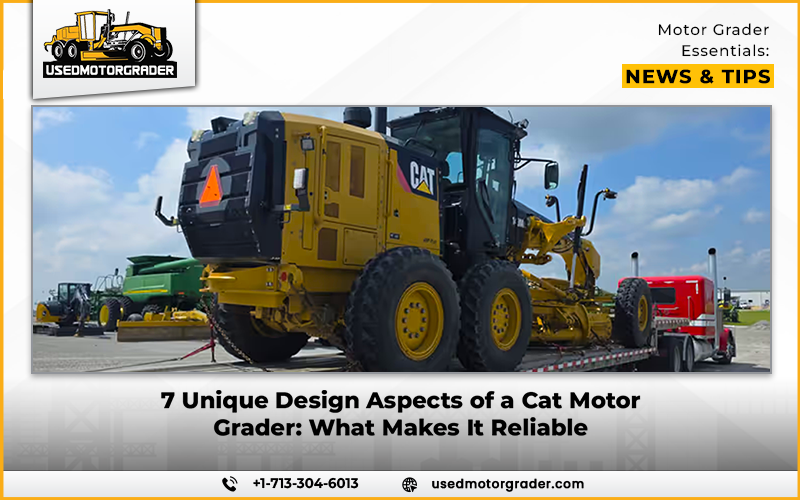The Cat motor grader is one of the most reliable machines in the construction industry when it comes to precision grading, roadwork, and site prep. It may be part of a new fleet of a contractor or it may be purchased as used heavy equipment, but the reputation of Cat motor graders is based on careful engineering and design that emphasizes performance. It is not only the brand name, but also the confidence in the real-life circumstances. So, what are the seven outstanding design features that make these graders continue to work efficiently on thousands of job sites?
1. Articulated Frame and Front-Wheel Steering
The articulated frame design is one of the major innovations of Cat motor grader models. This enables the machine to flex a little in the middle, which makes it navigate through tight corners and narrow work areas. When used with front-wheel steering, it provides the operator with a greater level of control over blade angle and turning radius. This aspect enhances the maneuverability of the machine in uneven terrain considerably without compromising on stability.
2. Load Sensing Hydraulic Systems
Not all hydraulic systems are created equal. Cat graders feature load-sensing hydraulics that respond based on the machine’s real-time needs. Instead of running at full pressure all the time, the hydraulic system adjusts flow and pressure depending on what the task requires. This not only enhances efficiency but also reduces wear and fuel consumption, a key advantage for those managing used heavy equipment.
3. A Frame Drawbar for Maximum Blade Control
Precision is everything in grading. Cat’s unique A-frame drawbar design gives operators precise control over blade movement. By distributing stress evenly and reducing vibration, the A-frame helps maintain consistent grading depth even in challenging soil or weather conditions.
Here’s what makes this design work so well:
- Improved structural stability of the moldboard
- Reduced blade chatter and bounce
- Better responsiveness when making fine adjustments
4. All-Wheel Drive Capability
Traction is the difference between productivity and productivity on uneven or slippery surfaces. Most Cat motor grader models have all-wheel drive systems where power is transmitted to the front and rear wheels. This arrangement significantly enhances traction on loose gravel, wet soil, or uphill slopes.
This feature has been cited by contractors operating in diverse settings, including highways and remote access roads, as one of the key reliability factors. To anyone who is using heavy equipment, the fact that the grader can grip and go is an added confidence.
5. Comfort-Driven Operator Environment
This may appear to be a luxury. However, operator comfort is directly related to productivity. The cabs of cat motor graders are designed to focus on visibility, ergonomic controls, and noise. These micro decisions on design matter when an operator is in a machine 8-10 hours a day.
The main comfort features are:
- Steering and joystick controls that are adjustable
- Filtered, ventilated, sealed cab
- Multi-position seating and suspension
The more comfortable the operator is, the more focused and efficient he/she is, which is rewarded with grading quality in the long run.
6. Integrated Technology and Automation
Cat motor grader models aren’t just steel and hydraulics anymore. Integrated technology has taken center stage. Features like Cat Grade with Cross Slope, Machine Drive Power (MDP), and auto-articulation assist operators in maintaining grade precision with less manual input. GPS-ready platforms also help streamline project workflows.
These built-in systems reduce rework, speed up training for new operators, and extend the useful life of used heavy equipment by minimizing operational errors.
7. Built for Serviceability
Downtime is a contractor’s worst enemy. Cat designs its graders with serviceability in mind. Operators or technicians can easily access components, reach filters, and use built-in diagnostic tools on the control panel during daily inspections or scheduled maintenance tasks.
- Grouped service points for faster checks
- Ground-level access to filters and drains
- Real-time diagnostics and alerts
For those managing used heavy equipment, easy maintenance means faster turnaround and reduced labor costs, which keeps the machine profitable longer.
The Value Behind the Design
All the design features of a Cat motor grader are geared towards a single objective: providing excellent performance under challenging job conditions. Whether you are operating a brand-new model or a trusted piece of used heavy equipment, the engineering detail will make the machine work as hard as you do. Cat knows that reliability is not a single characteristic, but rather it is the combination of many.
FAQs
Q1. Do Cat motor graders make good used equipment?
A: Yes. Their durable build, strong support structure, and reliable engineering make them good targets for resale and reuse.
Q2. Does the newer technology translate to older Cat graders?
A: Most Cat motor graders can be upgraded to have new technology, such as GPS grading or slope assist tools. Be sure of compatibility before buying
Q3. What is the frequency of servicing key systems on a Cat grader?
A: Basic service intervals are every 250-500 hours, but consult the model-specific manual to ascertain the exact schedules.
Q4. How long does a Cat motor grader last with proper maintenance?
A: With the right care, particularly when operators use them responsibly or rebuild them, Cat graders can last more than 15,000 working hours.


